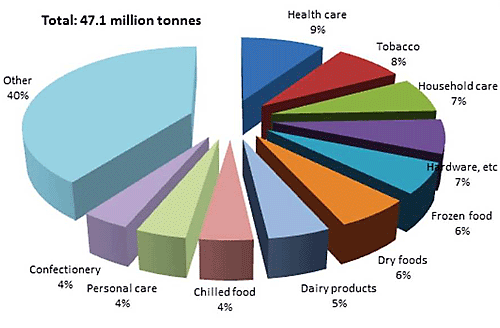
The Future of Folding Cartons to 2018 outlines the shape of the industry globally by end-use sector, region, and country, through extensive primary research. With strategic forecasts to 2018, plus details of key market drivers and opportunities, it analyzes major drivers and trends shaping the industry, and provides exclusive exploration of end-use markets and current and future worldwide demand.
Three key technologies that will result in added value in the folding carton market between 2013 and 2018 are retail-ready packs (mainly in microflute), anti-counterfeit systems, and barrier coating technologies. Retail-ready packaging is a growing trend among retailers striving to reduce their costs and comes in the form of corrugated/microflute systems, rigid plastic, and some rigid board products. Anti-counterfeit technology used in folding carton applications is expected to almost double with high growth expected, especially in the health care sector. Developments in water-based coatings, nano-materials, bio-polymers, and antimicrobial compounds are leading the growth for barrier coatings.
According to Smithers Pira, a global trend towards smaller packs will be offset by an increase in demand for single serve portion packs. Smaller packs tend to use more total packaging material than the larger packs they replace, for the same volume of packed product.
The need for continual brand differentiation in the crowded marketplace is the impetus of growing demand for innovation in printing methods, with an increase in such technologies as QR codes, holographic images, Fresnel lenses, and other 3D devices. The technological developments in printed electronics are bringing the development of smart packaging closer to fruition as costs are decreasing.
The following graph shows the top 10 end use markets for folding cartons in 2012:

Consumer electronics continue to offer great opportunities for folding cartons and microflute packs with the continued global growth in demand for mobile phones, tablets, and other personal devices.
The health care sector, accounting for nearly 10% of the folding cartons demand, will see a call for the development of smart packs able to provide a system for monitoring patient medication. The level of counterfeit goods, and the health threats these products pose, is stimulating demand for sophisticated track-and-trace systems in the form of either 1D barcodes, 2D barcodes, or RFID systems.
Global demand for convenience foods and the development of niche markets such as low calorie products are growth opportunities for both the dry and frozen foods sectors. In the confectionery market, perceived over-packaging has been a focus of consumer discontent, leading to considerable innovation in the packaging of seasonal products such as Easter eggs and Christmas gift packs.
According to the report, personal care market has shown a rapid recovery from the global recession and growth is being stimulated by the use of technology in the form of social media, mobile commerce, and in-store digital technologies, targeting the tech-savvy young consumer. Eco-friendly brands are gaining prominence and demand for innovating printing techniques such as Fresnel lenses is growing.
Globally, cartonboard production grew by 1.3% in 2012 to reach a total of 42.5 million metric tons, valued at $37.3 billion, with more than half of this volume located in the Asia-Pacific sector. The top five producers of cartonboard constituted almost 16% of the total volume in 2012, with the top 10 making up over a quarter. The 20 largest producers accounted for 40% of the market. Total volume of converted folding carton grew by more than 1% to reach 47.4 million metric tons in 2012, with 55% of this emanating in the Asia-Pacific sector. The five largest cartonboard converters make up almost 7% of this somewhat fragmented market, while the 10 largest converters accounted for more than 9% of the volume in 2012.
TAPPI
http://www.tappi.org/